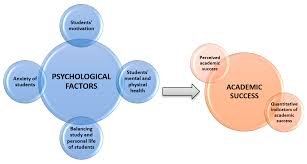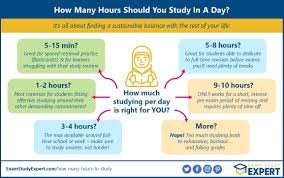1. Introduction
Figuring out how much time you should dedicate to studying each day isn’t always straightforward. The number of hours you need depends on your academic level, personal learning style, and how well you manage your time. This guide breaks down the ideal study hours based on your specific needs and helps you create a study routine that maximizes productivity while promoting well-being.
2. Factors That Influence How Much You Should Study
Academic Level and Course Requirements

Different academic levels come with different study expectations:
- High School: High school students might need 1-2 hours of study per day, especially if taking AP or honors courses.
- College Students: College students may need to study 2-3 hours per class, totaling about 15-20 hours per week for a full-time schedule.
- Graduate Students: Graduate students should allocate 4-6 hours of study per day, especially if working on a thesis or research projects.
Personal Learning Style

Understanding your personal learning style will help determine how much time you need:
- Visual Learners: These students may need extra time to organize notes, make diagrams, and watch videos.
- Auditory Learners: Can often absorb material quickly by listening to lectures, podcasts, and audiobooks.
- Kinesthetic Learners: Typically require more hands-on practice, so study time may involve more active methods like problem-solving or group discussions.
Study Goals and Deadlines
If you’re studying for an exam or a major project, your study time will increase. Prioritize tasks based on deadlines and difficulty:
- Daily Study: Regular study prevents cramming and reduces stress.
- Exam Prep: During finals, it’s common to increase your study time to 4-6 hours per day.
Health and Well being
Your physical and mental health directly impacts how long you can study productively:
- Sleep: Consistently getting enough sleep (7-9 hours) improves focus, memory, and retention.
- Exercise: Regular physical activity supports cognitive function and reduces stress.
- Mental Health: Anxiety or stress can impair your ability to focus, making it essential to balance study time with relaxation.
3. How Many Hours Should You Study Based on Your Goals
For High School Students

- General Recommendation: 1-2 hours per day on average, more during exams or when preparing for major assignments.
- Focus Areas: Spend more time on subjects that are challenging or have upcoming exams.
For College Students

- General Recommendation: Study for 2-3 hours for each hour spent in class. For example, if you have 15 hours of class per week, aim for 30-45 hours of study each week.
- Focus Areas: Advanced subjects or exams may require increased study time (up to 4-6 hours per day as exams approach).
For Graduate or Professional Studies
- General Recommendation: Expect to study 4-6 hours per day, especially for research-based or thesis programs.
- Focus Areas: Most of this time will be spent on research, writing, and intensive reading.
4. The Ideal Study Time Quality vs Quantity
Importance of Focused Study Sessions
Focusing on your study material with undivided attention often produces better results than sitting for long hours without focus. Quality time spent studying is more valuable than quantity.
Breaks and Their Importance
Regular breaks are essential to maintain mental clarity. The Pomodoro Technique, for instance, can help you work effectively for short bursts with 5-minute breaks in between, and longer breaks after four sessions. Studies show that breaks enhance learning by improving focus and memory retention.
5. The Role of Active Learning
Active vs Passive Learning
Active learning involves engaging with the material (e.g., summarizing, self-testing, teaching others) while passive learning is more about consuming information (e.g., reading or listening to lectures).
- Active Learning: Improves understanding and retention.
- Passive Learning: More useful for exposure but less effective for long-term memory.
Techniques to Maximize Learning in Less Time
- The Feynman Technique: Teach a concept as if you’re explaining it to a child. This will help identify areas you need to focus on and strengthen your understanding.
- Spaced Repetition: Review material at increasing intervals. This method is highly effective for long-term retention.
6. The Pomodoro Technique
What Is the Pomodoro Technique
The Pomodoro Technique is a time management method where you work in blocks of 25 minutes followed by 5-minute breaks. After four sessions, take a longer break (15-30 minutes).
How to Use the Pomodoro Technique Effectively
- Set a timer for 25 minutes and focus on studying a single task.
- After 25 minutes, take a short break (5 minutes).
- After 4 sessions, take a longer break to recharge.
Benefits and Challenges of Pomodoro
- Benefits: Helps maintain focus, prevents burnout, and makes studying feel less overwhelming.
- Challenges: Some tasks may require longer blocks of uninterrupted time, which doesn’t always fit into the Pomodoro structure.
Variations of the Pomodoro Technique
Some people prefer longer study sessions (e.g., 50 minutes of work and a 10-minute break). Experiment to find the best interval for you.
7. Time Management Tips for Effective Study
Creating a Study Schedule
A structured study schedule helps ensure you cover all subjects adequately. It also prevents last-minute cramming. Block out time for each subject, prioritizing based on difficulty and deadlines.
Setting Priorities and Goals
Set clear, achievable study goals for each session. This could include completing a set of problems, reading a chapter, or reviewing notes. Prioritize based on upcoming exams or assignments.
How to Stay Motivated
- Track Progress: Celebrate small achievements to keep motivation high.
- Reward Yourself: After completing a study session, treat yourself to something enjoyable.
- Switch Study Locations: Changing your environment can help refresh your focus.
Time Blocking for Studying
Time blocking involves setting specific hours for studying certain subjects. For instance, you might allocate 9 am-11 am for math, 11 am-1 pm for history, and so on. This helps ensure each subject receives focused attention.
8. Listening to Your Body Avoiding Burnout
The Importance of Sleep
Lack of sleep affects memory and cognitive function. Sleep is essential for consolidating memories, so try to sleep for at least 7 hours each night to maximize your study efforts.
Managing Stress
Study sessions can be stressful, but stress management techniques like mindfulness, meditation, or simply taking a short walk can help you stay calm and focused.
How to Recognize Mental Fatigue
Mental fatigue is a sign that you need a break. If you’re feeling tired, distracted, or frustrated, take a pause, relax, and come back to your studies when you’re refreshed.
9. Physical Health and Study How Exercise Affects Learning
The Link Between Physical Exercise and Cognitive Function
Exercise increases blood flow to the brain, which boosts memory, focus, and learning capacity. It also helps reduce anxiety and stress, which can improve study performance.
Types of Exercise to Boost Brain Health
- Aerobic Exercise: Activities like running, swimming, or cycling improve brain function.
- Strength Training: Lifting weights or resistance exercises boost cognitive abilities over time.
- Yoga and Stretching: Yoga enhances mental clarity and focus while reducing stress.
Importance of Physical Health in Academic Success
Staying physically active improves overall well-being, which translates into better concentration and productivity while studying.
10. When to Take a Break Knowing Your Limits
Recognizing When to Step Away from Studying
If you notice a drop in concentration or increasing frustration, it’s time to step away. Mental fatigue is a sign that your brain needs a rest.
The Importance of Downtime for Learning Retention
Taking breaks helps solidify what you’ve learned. The brain processes and consolidates information during rest periods, making breaks essential for long-term memory retention.
Techniques for Unwinding After Study Sessions
Engage in activities that relax you, like reading a book, taking a walk, or doing a creative hobby to give your mind a break from academic work.
11. Creating a Productive Study Environment
Setting Up an Effective Study Space
- Choose a quiet, comfortable location free from distractions.
- Ensure your study space is well-lit and organized.
- Have all necessary materials (books, laptop, stationery) within reach to avoid distractions.
Minimizing Distractions
- Put away your phone or use apps to block distracting websites.
- Let others know you need uninterrupted study time.
The Role of Lighting Temperature and Organization
Proper lighting reduces eye strain, and a comfortable room temperature enhances focus. An organized study space can also help you feel more productive and less stressed.
12. The Role of Technology in Studying
Helpful Study Apps and Tools
- Flashcard Apps: Anki or Quizlet for active recall.
- Time Management Tools: Forest or Trello to organize study schedules.
- Note-Taking Apps: Evernote or OneNote to keep your notes organized.
Using Technology to Enhance Productivity
Digital tools can help you stay on track, improve learning efficiency, and track progress. Use apps to stay organized, plan study sessions, and monitor your academic progress.
Limiting Distractions from Digital Devices
While technology can be beneficial, it can also be distracting. Use apps that help reduce distractions, or set your phone to “Do Not Disturb” while you study.
13. Study Strategies for Different Learning Styles
Visual Learners
- Use charts, graphs, and diagrams to reinforce your learning.
- Color-code your notes for better organization and easier recall.
Auditory Learners
- Record lectures or study sessions and listen to them for better understanding.
- Discuss topics with peers or professors to reinforce learning through conversation.
Kinesthetic Learners
- Engage in hands-on activities, such as practice problems, group discussions, or fieldwork.
- Use physical gestures or movement while studying to reinforce concepts.
14. Using Review and Self Testing to Improve Retention
Spaced Repetition for Long Term Memory
Spaced repetition involves reviewing material at increasing intervals, which helps move information from short-term to long-term memory.
How to Effectively Self Test
Practice with quizzes, flashcards, and mock exams to actively recall and reinforce what you’ve studied.
15. When to Seek Professional Help or Tutoring
Identifying When You Need Help
If you’re struggling with a concept or subject, don’t hesitate to seek help. Tutors, study groups, and professors can provide support.
Benefits of Seeking External Support
Tutoring offers personalized attention, helping you understand difficult concepts and clarify misunderstandings.
How to Find the Right Tutor or Study Group
Look for tutors with expertise in your subject area. Study groups can also be effective, as discussing material with peers often deepens understanding.
Table of Contents
Conclusion
Introduction
Factors That Influence How Much You Should Study
Academic Level and Course Requirements
Personal Learning Style
Study Goals and Deadlines
Health and Well-being
How Many Hours Should You Study Based on Your Goals?
For High School Students
For College Students
For Graduate or Professional Studies
The Ideal Study Time: Quality vs. Quantity
Importance of Focused Study Sessions
Breaks and Their Importance
The Role of Active Learning
Active vs. Passive Learning
Techniques to Maximize Learning in Less Time
The Feynman Technique for Deep Understanding
The Pomodoro Technique
What Is the Pomodoro Technique?
How to Use the Pomodoro Technique Effectively
Benefits and Challenges of Pomodoro
Variations of the Pomodoro Technique
Time Management Tips for Effective Study
Creating a Study Schedule
Setting Priorities and Goals
How to Stay Motivated
Time Blocking for Studying
Listening to Your Body: Avoiding Burnout
The Importance of Sleep
Managing Stress
How to Recognize Mental Fatigue
Physical Health and Study: How Exercise Affects Learning
The Link Between Physical Exercise and Cognitive Function
Types of Exercise to Boost Brain Health
Importance of Physical Health in Academic Success
When to Take a Break: Knowing Your Limits
Recognizing When to Step Away from Studying
The Importance of Downtime for Learning Retention
Techniques for Unwinding After Study Sessions
Creating a Productive Study Environment
Setting Up an Effective Study Space
Minimizing Distractions
The Role of Lighting, Temperature, and Organization
The Role of Technology in Studying
Helpful Study Apps and Tools
Using Technology to Enhance Productivity
Limiting Distractions from Digital Devices
Study Strategies for Different Learning Styles
Visual Learners
Auditory Learners
Kinesthetic Learners
Using Review and Self-Testing to Improve Retention
Spaced Repetition for Long-Term Memory
How to Effectively Self-Test
When to Seek Professional Help or Tutoring
Identifying When You Need Help
Benefits of Seeking External Support
How to Find the Right Tutor or Study Group
Conclusion
There is no one-size-fits-all answer to how many hours you should study per day. It depends on your goals, academic level, and personal learning style. By focusing on quality study sessions, using effective time management techniques, and listening to your body and mind, you can create a productive study routine that works for you. Remember, balance is key to academic success and well-being.

